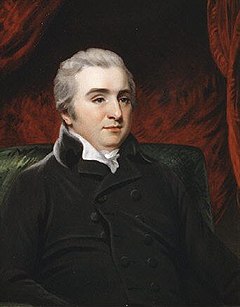Matthew Baillie
Matthew Baillie | |
|---|---|
 portrait by Henry Bone after John Hoppner | |
| Born | 27 October 1761 |
| Died | 23 September 1823 (aged 61) |
| Nationality | Scottish |
| Alma mater | University of Glasgow University of Oxford |
| Scientific career | |
| Fields | medicine pathology |
| Institutions | Royal College of Physicians |
Matthew Baillie
Early life and education
He was born in the manse at
Career
He was bequeathed £5000n on the death of his uncle
He was elected a
It was said of him,
His physical frame was feeble, compared with his mental powers. He was the middle stature, and of rather a slender form. His countenance was marked with a great deal of sagacity and penetration.[3]
Death
Baillie died of
Family
Baillie was married to Sophia Denman, the sister of Thomas Denman, 1st Baron Denman.
Works
His 1793 book, The Morbid Anatomy of Some of the Most Important Parts of the Human Body, is considered the first systematic study of pathology, and the first publication in English on pathology as a separate subject.[6] He is credited with first identifying transposition of the great vessels (TGV) and situs inversus. The 1793 book went into multiple editions and was translated into numerous languages, and five editions were released in Britain before his death.[7]
- The Morbid Anatomy of Some of the Most Important Parts of the Human Body (1793)
- Anatomy of the Gravid Uterus, by William Hunter published by Baillie (1794)
- A Series of Engravings, tending to illustrate the Morbid Anatomy of some of the most Important Parts of the Human Body (1799, 1802, 1812)
- Lectures and Observations on Medicine by the late Matthew Baillie (1825)
- An Account of a Particular Change of Structure in the Human Ovarium (Philosophical Transactions, London, 1789, Vol.79, pp. 71–78)
References
- ^ S2CID 221546486.
- ^ "Library and Archive Catalogue". Royal Society. Retrieved 4 March 2012.[permanent dead link]
- ^ The National Cyclopaedia of Useful Knowledge, Vol II (1847), London, Charles Knight, p.696.
- ^ 'The Abbey Scientists' Hall, A.R. p21: London; Roger & Robert Nicholson; 1966
- ^ Dictionary of British Sculptors 1660-1851 by Rupert Gunnis p.196
- ^ Matthew Baillie Encyclopædia Britannica Online. Retrieved on 11 August 2007.
- S2CID 210177467.
- Prichard, R (December 1979). "Selected items from the history of pathology. Transposition of the great vessels". PMID 389066.
- Prichard, R (December 1979). "Selected items from the history of pathology. Angina pectoris". PMID 389065.
- Prichard, R (December 1979). "Selected items from the history of pathology. Gastric leiomyoma". PMID 389064.
- Prichard, R (December 1979). "Selected items from the history of pathology. Intestinal cancer". PMID 228558.
- Prichard, R (July 1979). "Selected items from the history of pathology: Matthew Baillie (1761–1823)". PMID 380356.
- Longo, L D (December 1975). "Classic pages in obstetrics and gynecology: an account of a particular change of structure in the human ovarium. Matthew Baillie, 1789". PMID 1106198.
- Tubbs, R Shane; Loukas Marios; Shoja Mohammadali M; Oakes W Jerry (October 2007). "Matthew Baillie (1761–1823) and his early detailed descriptions of childhood hydrocephalus in the Morbid Anatomy". PMID 17941502.
- "Classics in oncology. Matthew Baillie (1761–1823)". CA: A Cancer Journal for Clinicians. 24 (1): 47–56. 1974. S2CID 221546486.
- Carr, I (1992). ""Not on the outward appearance .... but on the heart." Matthew Baillie and cardiology". The Canadian Journal of Cardiology. 8 (1): 78–82. PMID 1617515.
- Attwood, H D (August 1979). "Matthew Baillie—a possible early description of amniotic fluid embolism". The Australian & New Zealand Journal of Obstetrics & Gynaecology. 19 (3): 176–7. S2CID 36517147.
Further reading
- Bullough, Vern (1970). "Baillie, Matthew". ISBN 978-0-684-10114-9.
- Chambers, Robert; Thomson, Thomas Napier (1857). . A Biographical Dictionary of Eminent Scotsmen. Vol. 1. Glasgow: Blackie and Son. pp. 92–96 – via Wikisource.
See also
- Dr. Sir Richard Croft, 6th Baronet
- Hunterian Collection
External links
- AIM25: Royal College of Physicians: BAILLIE, Matthew (1761–1823) Royal College of Physicians.
- Balliol College, Oxford, archives List of Snell Exhibitioners from the University of Glasgow. Retrieved 2011-01-20
- Selected images from A series of engravings From The College of Physicians of Philadelphia Digital Library
